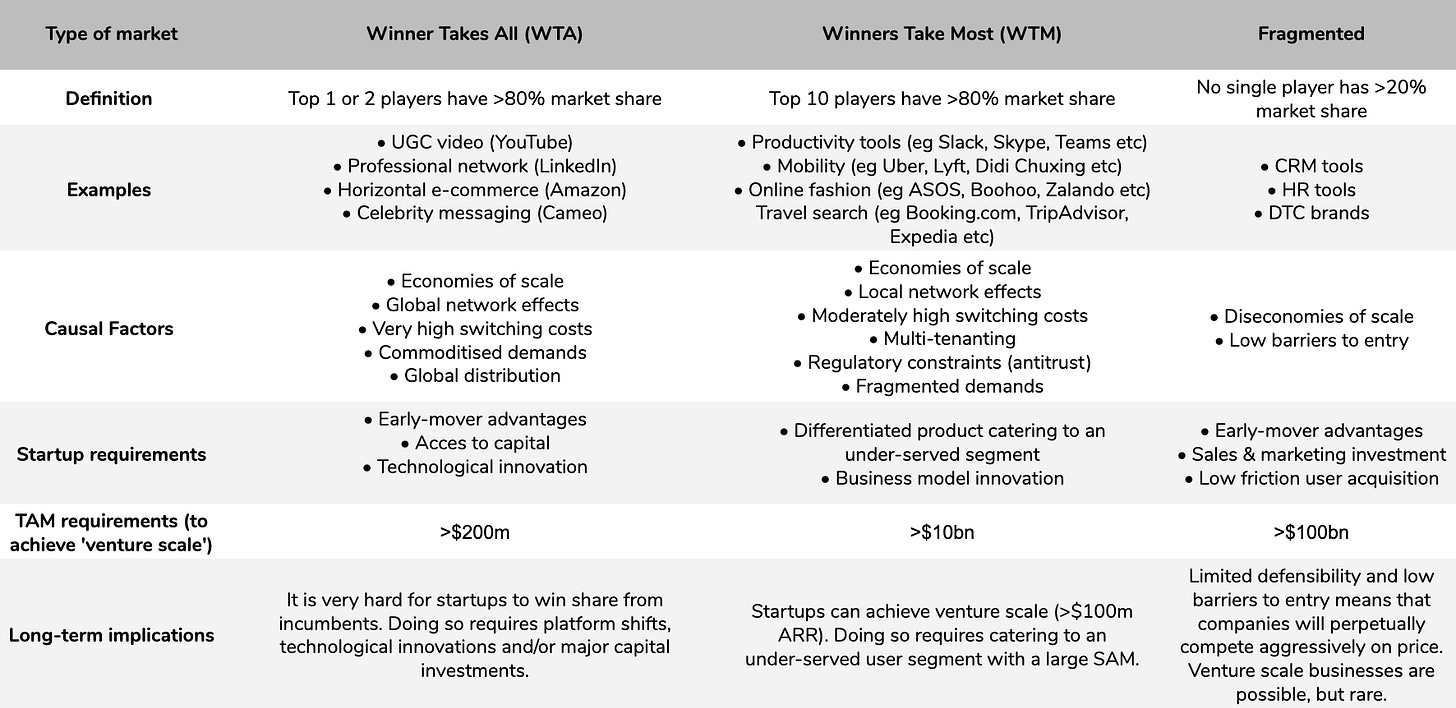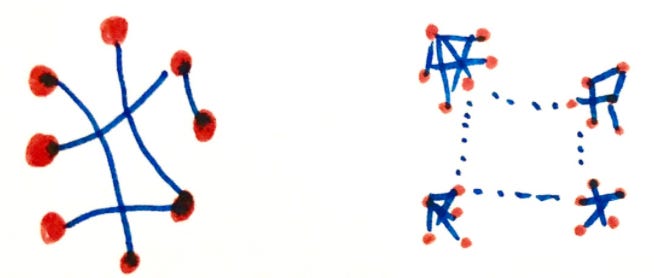How to Analyse a Competitive Landscape: A Framework for VCs and Founders
‘Competition is for losers. If you want to create and capture lasting value, look to build a monopoly’ - Peter Thiel

Competition is one of the key determinants of a startup’s success or failure. However, despite its importance, I find that many founders (and investors 🤭) only loosely understand the implications of competitive landscapes.
What does it really mean to say that a startup faces ‘tough competition?’ Does it matter that there are already existing companies serving the same customers? When can a startup successfully compete against Amazon or Google? When is a market too crowded?
In this post, I‘ll attempt to answer these questions. I discuss three types of market structure:
Winner takes all (WTA)
Winners take most (WTM)
Fragmented
I’ll outline the causal factors that lead to each of these market structures. Most importantly, I’ll discuss how startups can successfully operate within each structure.
I hope that this framework will be helpful to both entrepreneurs and investors in assessing early-stage, competitive strategy.
TL;DR

Winner takes all (WTA) 💰💰💰
Description
A market in which the top one or two companies capture a large share (>80%) of revenues.
The causal factors that lead to this market structure mean that the dominant player(s) have very deep moats — making competition incredibly challenging. As Ben Thompson articulates it — incumbents can be eclipsed, not displaced.
Most WTA markets are dominated by behemoths (eg YouTube in UGC video, Google in Web search, and Amazon in horizontal e-commerce). However, there are examples of smaller and more niche WTA markets (eg Cameo with celebrity messaging). Global network effects are the key contributor to these niche WTA markets (discussed below).
WTA markets require a Total Addressable Market (TAM) size >$200m to achieve venture scale (assuming the top 2 players capture >80% market share).
Causal factors
Economies of scale ⚖️
One of the key contributing factors to WTA markets is the presence of economies of scale. Some products have considerable fixed cost requirements. For example, the supply chain investments required to facilitate a vertically integrated, horizontal e-commerce business like Amazon are vast. In these instances, being bigger than the competition becomes a major advantage. Bigger companies can spread these fixed costs across more users, resulting in a lower cost per user/unit relative to smaller competitors.
Once a company reaches a certain size, its cost advantage becomes insurmountable to most new entrants. The dominant company can use predatory pricing to price the products at below-cost pricing. Consequently, other firms cannot compete, and eventually have to exit the market. Amazon has been accused of such a practices in the past. The chart below shows how the company sacrificed profits for decades in the pursuit of impenetrable scale advantages.

Economies of scale on their own can only lead to WTM markets, not WTA markets. Provided the revenue potential is large enough, investors will be willing to provide new entrants with enough capital to compete against the incumbent. Investors will see through near-term losses with the view that once the new entrant has achieved scale, the economics will be more favourable.
As such, economies of scale must be combined with another one of the causal factors discussed below to yield a WTA market.
(Global) Network effects 🕸
A network effect occurs when the value of a product or service goes up as more people use it. Telephones, eBay, and WhatsApp are good examples of network effects at work. The more people that use WhatsApp, the more people one can contact, and thus, the more valuable the product.

The telephone is a commonly cited example of network effects at work. The more users (nodes) in the network, the more valuable the network becomes.
The type of network is what determines the degree of fragmentation in a market. Network effects create WTA markets when the network is based on a global network (rather than a local network).
A global network is one in which each node is theoretically connected to every other node in the network. Each new (random) connection adds value to the entire network. A telephone network is the best example of a global network effect. New additions (telephone users) makes the ecosystem more valuable, since there are more potential points of contact. The presence of global network effects is one of the key contributors to WTA markets. The stronger the network effects, the more concentrated the market will be. Examples of this happening in practice include YouTube, LinkedIn and Cameo.

Global network (left) vs Local or clustered network (right). Global network effects create WTA markets; whereas local network effects are more likely to create WTM or Fragmented markets.
Global networks are in contrast to local networks. A local network is when the nodes are connected in clusters, based on a common modalities, such as physical location, common interests or employers. An example of a local network is Slack. The addition of unconnected participants to the network adds negligible value to users. It is unlikely that existing users will ever communicate with a new random user, unless the new user joins the existing user’s cluster (Slack Group). Value is only added each time someone within the cluster joins Slack (eg a new employee of the same company).
Local network effects provide defensibility — but only in ‘clusters’. Additionally, clustering allows value to be increased faster than in global networks. These features lead to markets with several dominant players. Local network effects explain why enterprise IMs have a WTM market structure (ie Slack, Skype, Teams, Stride are all significant players in the space).
The more localised a network, the more fragmented the market structure. For example, in the CRM space, there are hundreds of players, due to fact that network effects are clustered based on many different industry verticals.
High switching costs 🤯
If the cost or inconvenience of migrating to a different product are high, a product will be sticky. Customers are ‘locked in’. For example, the costs of an organisation switching to a new operating system are significant. Consequently, these occurrences may only occur every few decades. This stickiness results in WTA and WTM markets.
The more sticky the dominant product(s), the more concentrated the market will be.
Global distribution 🌍
The ability to access all potential customers of a product is a crucial facet of WTA markets. If boundaries exist (eg geographic or regulatory barriers) then competing companies (eg local alternatives) can cater to these under-served customer groups. This would result in WTM or Fragmented markets.
Commoditised demands 🤷♂️
For one player to dominate the entire market, user demands must be relatively commoditised (ie all users are happy with the same product or service).
For example, in the confines of our current technology, it is difficult to imagine how one could differentiate Web search well enough to actively take on Google.
What startups need to compete in a WTA market
Early mover advantages 🥇
Early entry enables companies to benefit from economies of scale, build a moat based on network effects, and avoid the challenges associated with acquiring ‘locked in’ users. It is important to note that the first mover does not necessarily have the greatest advantage.
Technological innovation 💾
WTA disruption is infrequent. Startups products must be able to provide an experience that is 10x better than the incumbents (eg Microsoft’s PC vs Intel’s Mainframe). This often requires major technological innovations and/or platform shifts. For example, Web search in its current incarnation is only likely to be disrupted once AI is cogent enough to answer users’ questions directly.
Access to capital 💸
Since WTA markets often benefit from economies of scale, startups may require significant capital investments to take on the incumbent.
Winners take most (WTM) 💰💰
Description
A WTM market is a concentrated market structure in which the top 10 players capture a large share (>80%) of revenues.
While barriers to entry do exist, startups can win market share through product differentiation and/or strategic positioning. Since products are differentiated, it is possible for companies to compete on more than just price. This enables them to achieve attractive SaaS margins (60–80%) over the long-run.
For startups looking to raise venture capital, this is the best market structure to address. To achieve venture scale, startups should seek a Total Addressable Market (TAM) >$10bn.
Examples of WTM markets include mobility (ie Uber, Lyft, Didi Chuxing, Gett, Addison Lee, Grab, Bolt), travel search-engines (ie Booking.com, TripAdvisor, Expedia, Skyscanner) and online fashion (ie ASOS, Boohoo, Zalando, Farfetch, Depop).
Causal factors
All the factors that contribute to WTA markets also contribute to WTM markets. However, the addition of the following factors makes them WTM, rather than WTA.
Multi-tenanting 👯
Multi-tenanting is the ability for users of a product to use alternative products simultaneously — with very low friction. For example, when using social networks, the costs associated with uploading a photo to both Facebook and Instagram are negligible. Similarly, sellers can list the same product on eBay and Cragislist simultaneously with little effort. Multi-tenanting weakens the strength of network effects, resulting in a greater fragmentation of the market.
(Local) network effects 🕸
As discussed in the section above.
Regulatory constraints 👨🏻⚖️
Antitrust regulations may turn WTA markets into WTM. The European Commission’s stance on Google’s dominance of the online advertising market is a recent example of this in practice. Regulatory decisions may create opportunities for the long tail to capture market share.
Fragmented demands 👨👩👧👦
If there are many different types of user, there will be more demand for product differentiation. This results in a more fragmented market structure. Common dimensions of differentiation include breadth vs focus, cost vs quality, simplicity vs sophistication and performance vs speed.
What startups need to compete in a WTM market
Differentiated products that cater to under-served segments 🥱
To succeed in WTM markets, startups must create product experiences that address the pain points of a specific segment of the market. In an attempt to capture a wide segment of the market, incumbents will most likely build broader and less focussed products. This enables competition to emerge. For example, Superhuman catered to the segment of email users who placed considerable value on productivity and efficiency; Robinhood focussed on catering to users with minimal knowledge of finance, but an interest in investing in stocks; Masterclass focussed on users who are interested in paying a premium for celebrity tutorials. Provided the value of that segment (Serviceable Addressable Market — SAM) is large enough, there will be an opportunity for startups to reach considerable scale.
Business model innovation 🙃
Changing a business model changes the economic make-up of a business. This can enable effective competition with incumbents.
For example, startups can adopt a marketplace model instead of a B2C model (eg Depop vs ASOS). This diminishes the power of the incumbent’s economies of scale. In the case of Depop, the fixed costs associated with launching a vertically integrated e-commerce business were eradicated by transferring these over to the marketplace’s sellers.
Startups can also win share by innovating on pricing models. For example, a freemium model can lower the switching costs for users. Google Docs used this approach to successfully to win market share from Microsoft Word.
Fragmented 💰
Description
A market structure in which no single player captures >20% of revenues. Instead, there is a long-tail of companies, all competing for the same customers.
Most businesses operating in fragmented markets will not grow to venture scale. They can only grow to a size that is too small to justify the risks associated with venture investment. It is possible to achieve venture scale. However, it is much more challenging to do so. To de-risk investments, investors should look for a TAM >$100bn.
These market structures are best suited to founders looking to build lifestyle businesses or private equity firms looking to adopt a ‘roll-up’ strategy.
Examples include CRM tools, HR tools and D2C brands.
Causal factors
Diseconomies of scale 📉
In certain instances, it is a weakness to have more users/scale. For example, if fixed costs are low but variable costs are high, there are limited cost advantages to scale. In these instances, more scale results in more complexity, and thus more cost inefficiency.
Diseconomies of scale are not just restricted to costs. There may be brand implications. For example, D2C brands may see their brand being tarnished as they scale (and become more ‘mainstream’). Diseconomies of scale might also include an inability to deliver effective service and personalisation as a business scales.
These diseconomies provide smaller players with advantages — which increases the fragmentation of a market.
Low barriers to entry 𝌉
Provided a market is large enough, low barriers to entry will entice new entrants into a market. The lower the barriers, the higher the fragmentation.
What startups need to compete in a Fragmented market
Early-mover advantages 🥇
Early movers are best placed to compete in fragmented markets. By entering a market first, startups can develop a strong brand as the established incumbent. For example, Salesforce has a ~20% market share of the global CRM market. While competition is tough and fragmentation is high (for the reasons mentioned above), Salesforce’s brand provides it with a moat which enables it to defend its market share.
Sales & marketing investment 👨💼
Low barriers to entry means that many similar products will compete for market share. This reduces the differentiation in the market. Since differentiation is low, startups must win share through strong sales and marketing efforts. This requires investing appropriately in sales and marketing staff. Additionally, companies can innovate with effective Growth marketing (eg baking viral loops into the product).
Low friction user acquisition 💆♀️
Since there are so many competitors, a startup must make it as easy as possible for users to migrate to their product. If the friction is too high, users will simply opt for one of the many competing products or services.
Summary
Not all market structures are born equal. Founders and VCs should always identify which of the three market structures their company is operating in.
If there are limited advantages to scale, low barriers to entry and no network effects, the market will likely become fragmented. Fragmented markets are easy to enter, but difficult to achieve considerable scale in. Such markets are highly competitive, and are more likely to produce lifestyle businesses than venture scale companies.
WTA markets are often difficult to enter. Disruption happens infrequently, and generally requires fundamental shifts in technologies and platforms. Startups can succeed in (niche) WTA markets by building innovative products that cater to niche uses cases and benefit from global network effects.
WTM markets are the most attractive from a venture perspective. Startups can win share from incumbents by addressing the pain points of a specific user segment, or through business model innovation. Provided the TAM and SAM are large enough, these markets can often accommodate several (5–15) venture scale businesses.
If you’re a startup founder and want to chat about your competitive strategy — drop me a line on omar@rooksnestventures.com 👋

